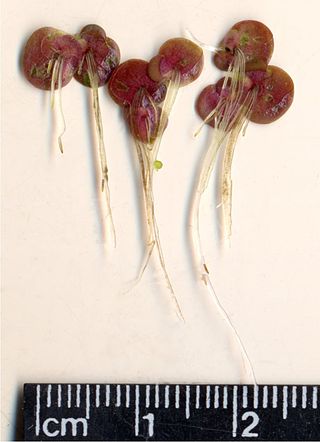
The Araceae are a family of monocotyledonous flowering plants in which flowers are borne on a type of inflorescence called a spadix. The spadix is usually accompanied by, and sometimes partially enclosed in, a spathe. Also known as the arum family, members are often colloquially known as aroids. This family of 140 genera and about 4,075 known species is most diverse in the New World tropics, although also distributed in the Old World tropics and northern temperate regions.

A wetland is a distinct ecosystem that is flooded or saturated by water, either permanently for years or decades or seasonally for a shorter periods. Flooding results in oxygen-free anoxic processes prevailing, especially in the soils. The primary factor that distinguishes wetlands from terrestrial land forms or water bodies is the characteristic vegetation of aquatic plants, adapted to the unique anoxic hydric soils. Wetlands are considered among the most biologically diverse of all ecosystems, serving as home to a wide range of plant and animal species. Methods for assessing wetland functions, wetland ecological health, and general wetland condition have been developed for many regions of the world. These methods have contributed to wetland conservation partly by raising public awareness of the functions some wetlands provide. Constructed wetlands are designed and built to treat municipal and industrial wastewater as well as to divert stormwater runoff. Constructed wetlands may also play a role in water-sensitive urban design.

Aquatic plants are plants that have adapted to living in aquatic environments. They are also referred to as hydrophytes or macrophytes to distinguish them from algae and other microphytes. A macrophyte is a plant that grows in or near water and is either emergent, submergent, or floating. In lakes and rivers macrophytes provide cover for fish, substrate for aquatic invertebrates, produce oxygen, and act as food for some fish and wildlife.

Lemna is a genus of free-floating aquatic plants referred to by the common name "duckweed". They are morphologically divergent members of the arum family Araceae. These rapidly growing plants have found uses as a model system for studies in community ecology, basic plant biology, ecotoxicology, and production of biopharmaceuticals, and as a source of animal feeds for agriculture and aquaculture. Currently, 14 species of Lemna are recognised.

Spirodela is a genus of aquatic plants, one of several genera containing plants commonly called duckweed. Spirodela species are members of the Araceae under the APG II system. They were formerly members of the Lemnaceae.
This article gives an overview of the aquatic communities in the British National Vegetation Classification system.

Spirodela punctata is a species of duckweed (Lemnoideae). The species is morphologically intermediate between Lemna and other species of Spirodela. In 1999 D.H. Les and D.J. Crawford proposed segregating the species to a new genus Landoltia containing just the species L. punctata, on the basis of biochemical and DNA studies.

Wolffia is a genus of aquatic plants with a cosmopolitan distribution. They include the smallest flowering plants on Earth. Commonly called watermeal or duckweed, these aquatic plants resemble specks of cornmeal floating on the water. They often float together in pairs or form floating mats with related plants, such as Lemna and Spirodela species.

Lemna minor, the common duckweed or lesser duckweed, is a species of aquatic freshwater plant in the subfamily Lemnoideae of the arum family Araceae. L. minor is used as animal fodder, bioremediator, for wastewater nutrient recovery, and other applications.

Joachim Wilhelm "Jo" Messing was a German-American biologist who was a professor of molecular biology and the fourth director of the Waksman Institute of Microbiology at Rutgers University.

Cataclysta lemnata, the small china-mark, is a moth species of the family Crambidae. It is found in Europe, Morocco and Iran.

The Sifton Bog Environmentally Significant Area is a wetland jointly administered by the city of London, Ontario and the Upper Thames River Conservation Authority. It is located west of Hyde Park Road and south of Oxford Street inside the city limits of London, Southern Ontario, Canada. It is a Class 2 provincially significant wetland.
Wayne P. Armstrong is a natural historian, author, photographer and creator of the extensive online natural history textbook, Wayne's Word: An Online Textbook Of Natural History.

Spirodela polyrhiza is a species of duckweed known by the common names common duckmeat, greater duckweed, great duckmeat, common duckweed, and duckmeat. It can be found nearly worldwide in many types of freshwater habitat.

Wolffia arrhiza is a species of flowering plant known by the common names spotless watermeal and rootless duckweed, belonging to the Araceae, a family rich in water-loving species, such as Arum and Pistia. It is the smallest vascular plant on Earth. It is native to Europe, Africa, and parts of Asia, and it is present in other parts of the world as a naturalized species.

Lemna aequinoctialis, the lesser duckweed, is a tiny, floating aquatic plant in the aroid family, found in quiet, still waters of the Southern U.S., as well as México and some Caribbean Islands. Additionally, it can be found from the state of Virginia south through Florida, north to Nebraska and even into southern Wisconsin. It is also widespread in the American Southwest, from Texas to the coast of California, preferring lagoons and still ponds, which it accesses via seasonal flooding and occasional precipitation. Fronds are generally triple-nerved, green, and measure up-to 6 mm long. Flowers are single-ovulate, with a small utricular scale open on one side. Seeds have 8–26 ribs.

Elophila turbata is a moth in the family Crambidae found in Africa and Asia. It was first described by the English entomologist Arthur Gardiner Butler in 1881 from a specimen found in Yokohama, Japan.























